Financial Accounting Report: Income Statement and Balance Sheet
VerifiedAdded on 2021/02/20
|16
|3926
|79
Report
AI Summary
This report provides a comprehensive overview of financial accounting principles and practices. It begins with an introduction to financial accounting, defining its role in recording, summarizing, and reporting business transactions. The report then delves into the specifics of financial statements, including the income statement, balance sheet, and statement of cash flows, illustrating their components and purposes with examples. It explores the differences between the income statement and balance sheet, highlighting key items like revenue, assets, liabilities, and equity. The report also covers the statement of profit and loss, and analyzes financial statements to assess a company's financial health, ability to repay debts, and overall performance. The report includes worked examples and working notes to demonstrate how to prepare and interpret these financial statements. Finally, the report discusses the uses of financial statements for various stakeholders, such as investors and creditors, and emphasizes the importance of accurate and reliable financial reporting.
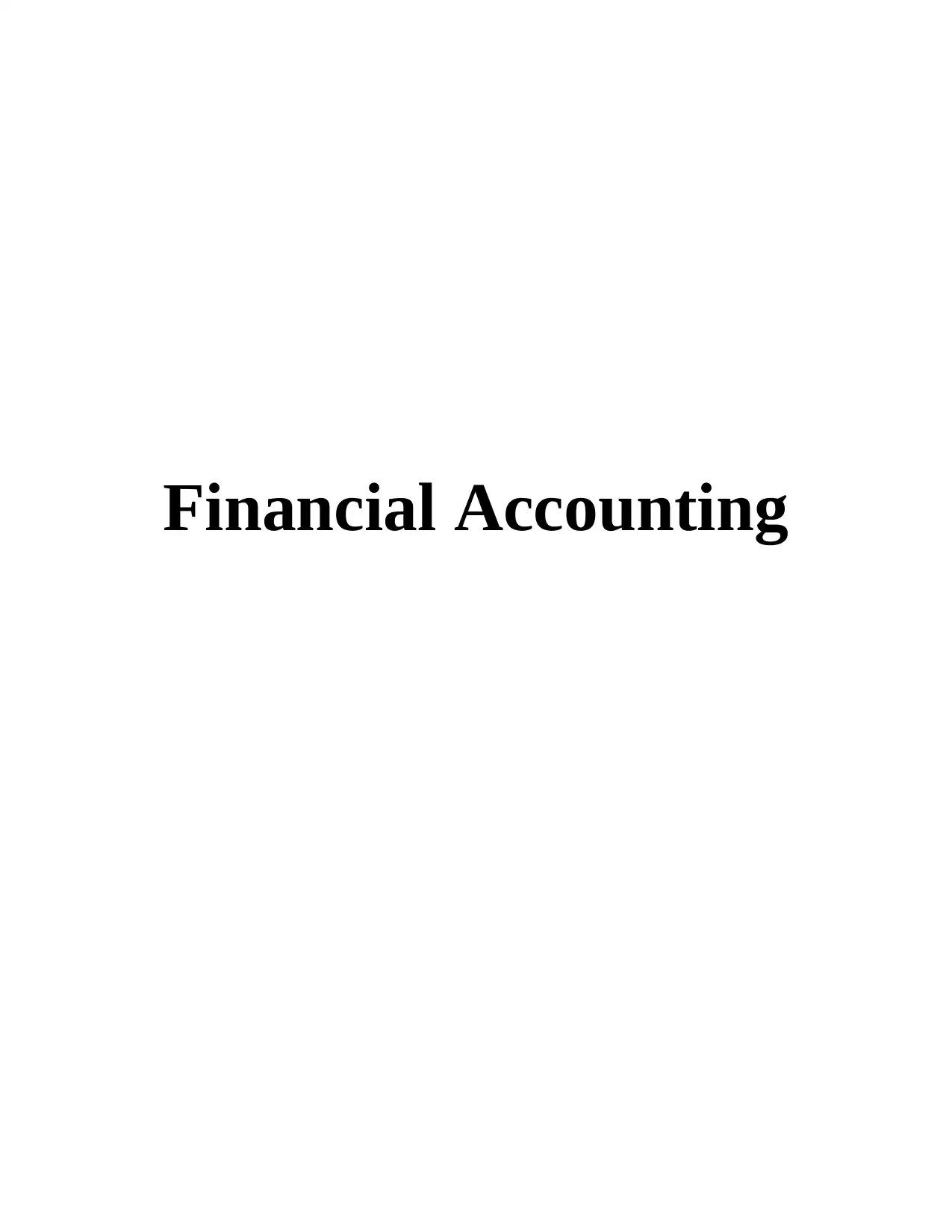
Financial Accounting
Paraphrase This Document
Need a fresh take? Get an instant paraphrase of this document with our AI Paraphraser
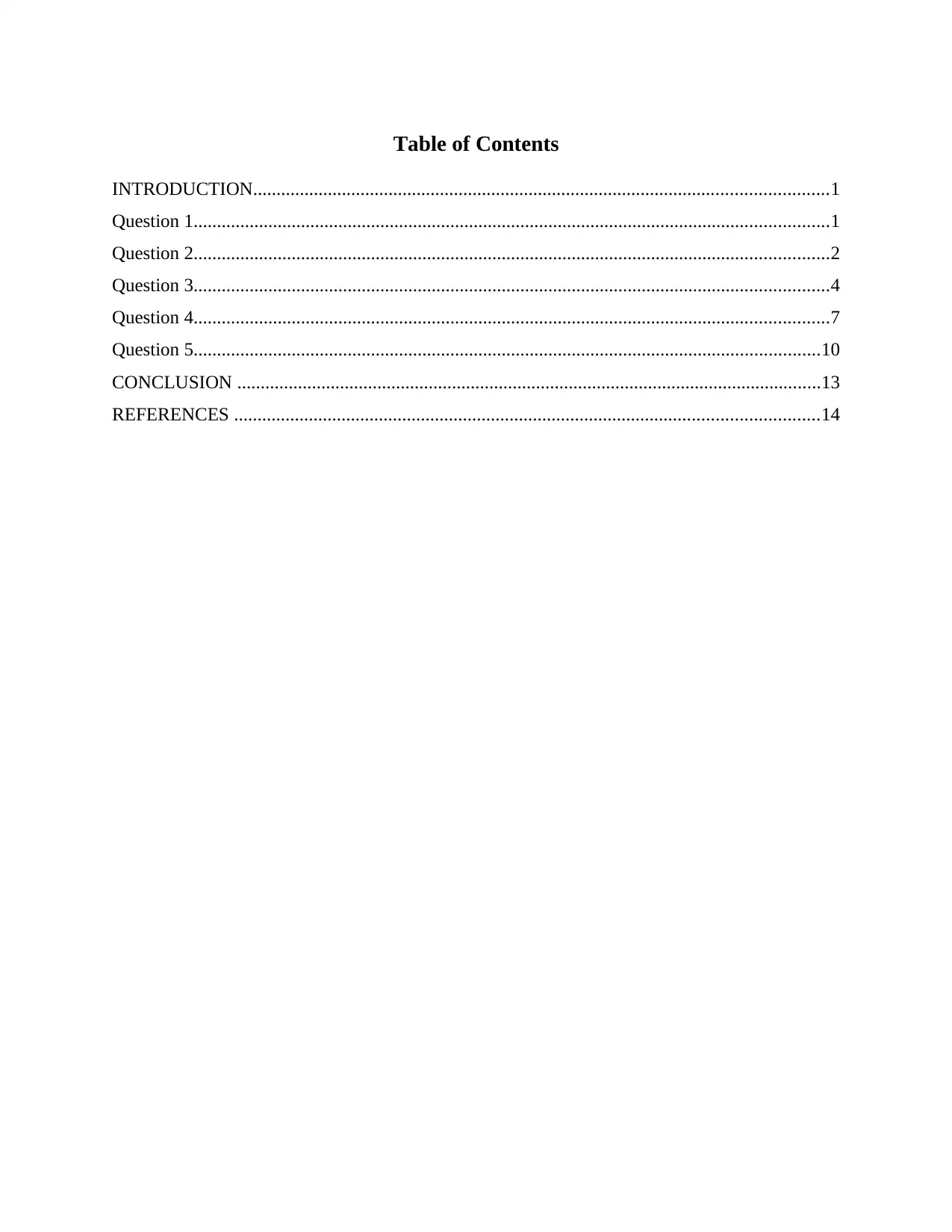
Table of Contents
INTRODUCTION...........................................................................................................................1
Question 1........................................................................................................................................1
Question 2........................................................................................................................................2
Question 3........................................................................................................................................4
Question 4........................................................................................................................................7
Question 5......................................................................................................................................10
CONCLUSION .............................................................................................................................13
REFERENCES .............................................................................................................................14
INTRODUCTION...........................................................................................................................1
Question 1........................................................................................................................................1
Question 2........................................................................................................................................2
Question 3........................................................................................................................................4
Question 4........................................................................................................................................7
Question 5......................................................................................................................................10
CONCLUSION .............................................................................................................................13
REFERENCES .............................................................................................................................14
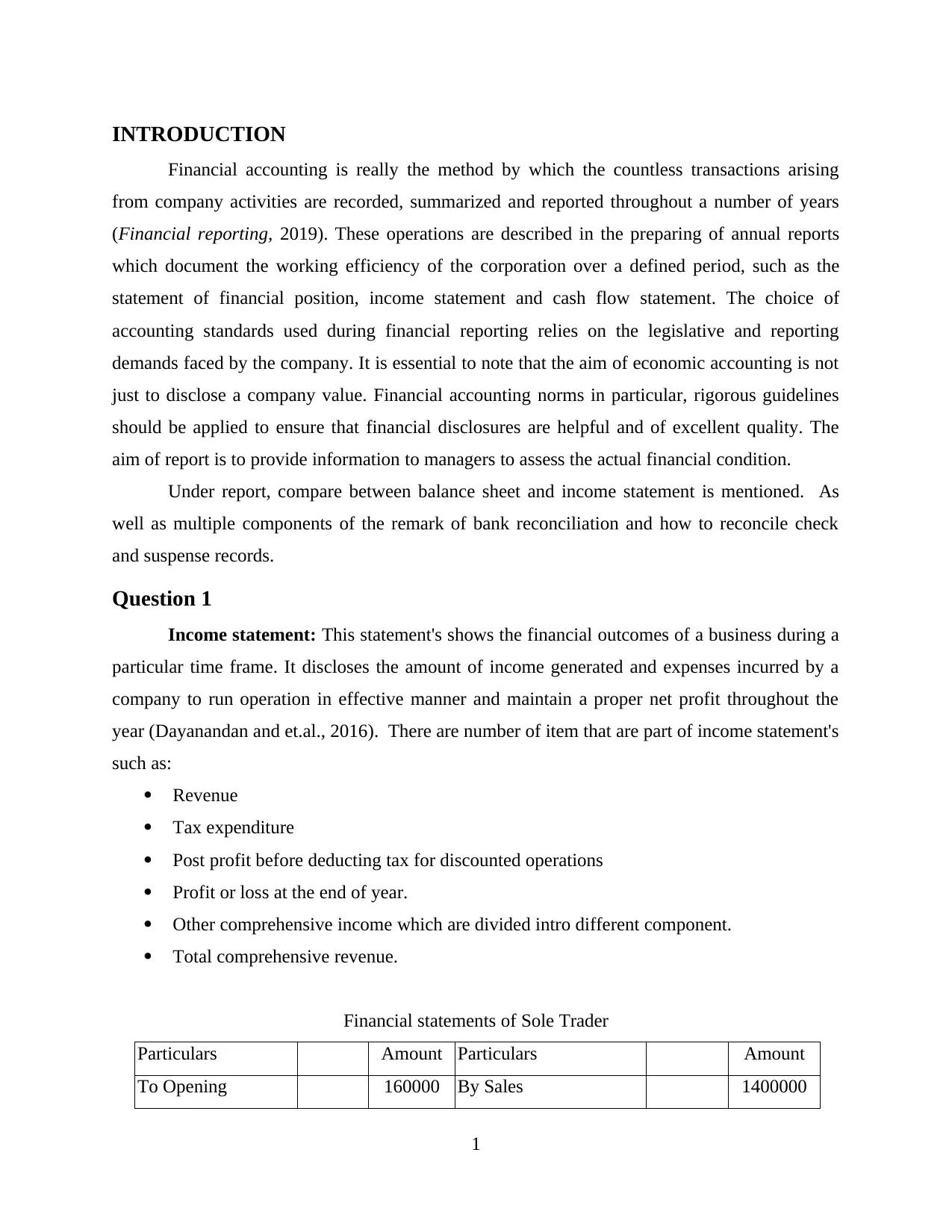
INTRODUCTION
Financial accounting is really the method by which the countless transactions arising
from company activities are recorded, summarized and reported throughout a number of years
(Financial reporting, 2019). These operations are described in the preparing of annual reports
which document the working efficiency of the corporation over a defined period, such as the
statement of financial position, income statement and cash flow statement. The choice of
accounting standards used during financial reporting relies on the legislative and reporting
demands faced by the company. It is essential to note that the aim of economic accounting is not
just to disclose a company value. Financial accounting norms in particular, rigorous guidelines
should be applied to ensure that financial disclosures are helpful and of excellent quality. The
aim of report is to provide information to managers to assess the actual financial condition.
Under report, compare between balance sheet and income statement is mentioned. As
well as multiple components of the remark of bank reconciliation and how to reconcile check
and suspense records.
Question 1
Income statement: This statement's shows the financial outcomes of a business during a
particular time frame. It discloses the amount of income generated and expenses incurred by a
company to run operation in effective manner and maintain a proper net profit throughout the
year (Dayanandan and et.al., 2016). There are number of item that are part of income statement's
such as:
Revenue
Tax expenditure
Post profit before deducting tax for discounted operations
Profit or loss at the end of year.
Other comprehensive income which are divided intro different component.
Total comprehensive revenue.
Financial statements of Sole Trader
Particulars Amount Particulars Amount
To Opening 160000 By Sales 1400000
1
Financial accounting is really the method by which the countless transactions arising
from company activities are recorded, summarized and reported throughout a number of years
(Financial reporting, 2019). These operations are described in the preparing of annual reports
which document the working efficiency of the corporation over a defined period, such as the
statement of financial position, income statement and cash flow statement. The choice of
accounting standards used during financial reporting relies on the legislative and reporting
demands faced by the company. It is essential to note that the aim of economic accounting is not
just to disclose a company value. Financial accounting norms in particular, rigorous guidelines
should be applied to ensure that financial disclosures are helpful and of excellent quality. The
aim of report is to provide information to managers to assess the actual financial condition.
Under report, compare between balance sheet and income statement is mentioned. As
well as multiple components of the remark of bank reconciliation and how to reconcile check
and suspense records.
Question 1
Income statement: This statement's shows the financial outcomes of a business during a
particular time frame. It discloses the amount of income generated and expenses incurred by a
company to run operation in effective manner and maintain a proper net profit throughout the
year (Dayanandan and et.al., 2016). There are number of item that are part of income statement's
such as:
Revenue
Tax expenditure
Post profit before deducting tax for discounted operations
Profit or loss at the end of year.
Other comprehensive income which are divided intro different component.
Total comprehensive revenue.
Financial statements of Sole Trader
Particulars Amount Particulars Amount
To Opening 160000 By Sales 1400000
1
⊘ This is a preview!⊘
Do you want full access?
Subscribe today to unlock all pages.

Trusted by 1+ million students worldwide
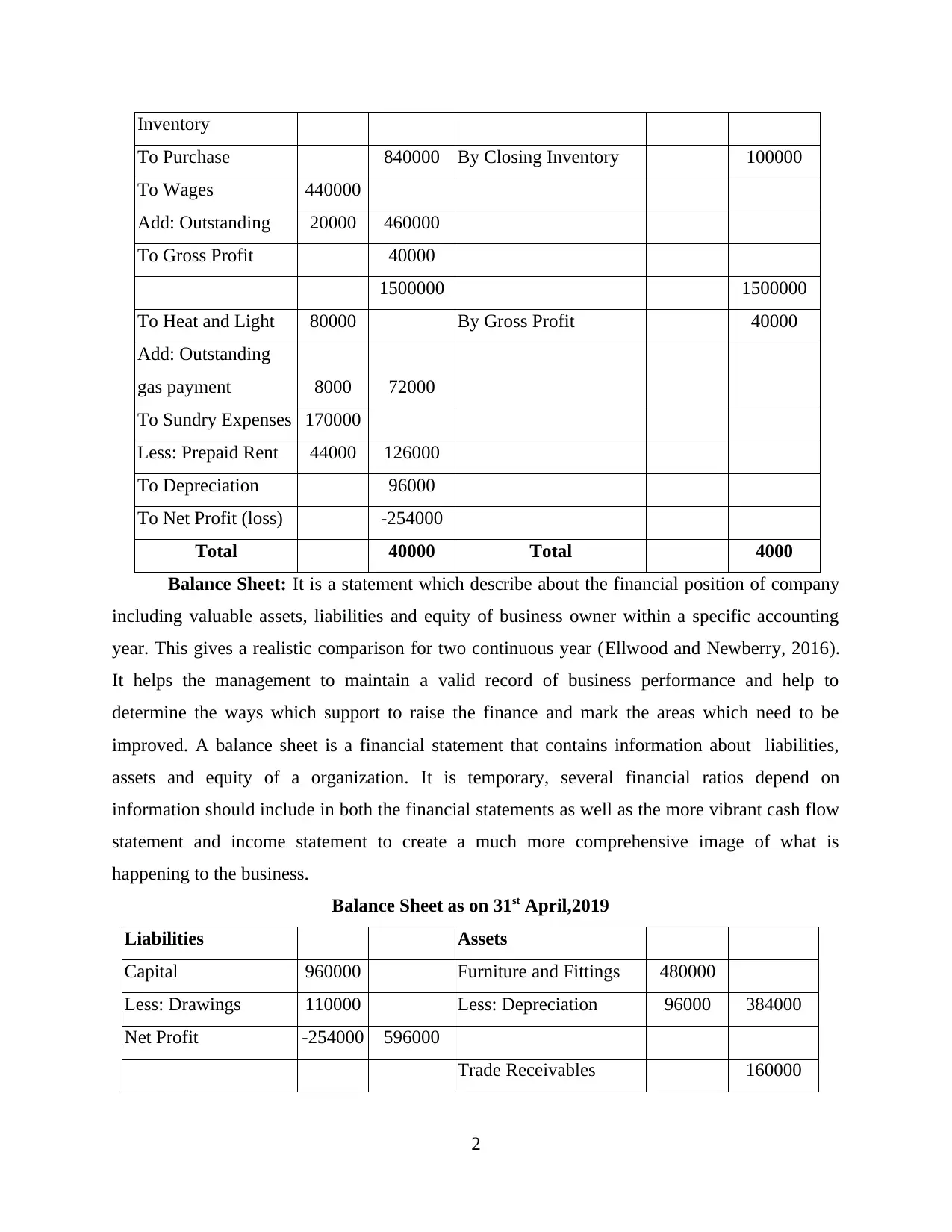
Inventory
To Purchase 840000 By Closing Inventory 100000
To Wages 440000
Add: Outstanding 20000 460000
To Gross Profit 40000
1500000 1500000
To Heat and Light 80000 By Gross Profit 40000
Add: Outstanding
gas payment 8000 72000
To Sundry Expenses 170000
Less: Prepaid Rent 44000 126000
To Depreciation 96000
To Net Profit (loss) -254000
Total 40000 Total 4000
Balance Sheet: It is a statement which describe about the financial position of company
including valuable assets, liabilities and equity of business owner within a specific accounting
year. This gives a realistic comparison for two continuous year (Ellwood and Newberry, 2016).
It helps the management to maintain a valid record of business performance and help to
determine the ways which support to raise the finance and mark the areas which need to be
improved. A balance sheet is a financial statement that contains information about liabilities,
assets and equity of a organization. It is temporary, several financial ratios depend on
information should include in both the financial statements as well as the more vibrant cash flow
statement and income statement to create a much more comprehensive image of what is
happening to the business.
Balance Sheet as on 31st April,2019
Liabilities Assets
Capital 960000 Furniture and Fittings 480000
Less: Drawings 110000 Less: Depreciation 96000 384000
Net Profit -254000 596000
Trade Receivables 160000
2
To Purchase 840000 By Closing Inventory 100000
To Wages 440000
Add: Outstanding 20000 460000
To Gross Profit 40000
1500000 1500000
To Heat and Light 80000 By Gross Profit 40000
Add: Outstanding
gas payment 8000 72000
To Sundry Expenses 170000
Less: Prepaid Rent 44000 126000
To Depreciation 96000
To Net Profit (loss) -254000
Total 40000 Total 4000
Balance Sheet: It is a statement which describe about the financial position of company
including valuable assets, liabilities and equity of business owner within a specific accounting
year. This gives a realistic comparison for two continuous year (Ellwood and Newberry, 2016).
It helps the management to maintain a valid record of business performance and help to
determine the ways which support to raise the finance and mark the areas which need to be
improved. A balance sheet is a financial statement that contains information about liabilities,
assets and equity of a organization. It is temporary, several financial ratios depend on
information should include in both the financial statements as well as the more vibrant cash flow
statement and income statement to create a much more comprehensive image of what is
happening to the business.
Balance Sheet as on 31st April,2019
Liabilities Assets
Capital 960000 Furniture and Fittings 480000
Less: Drawings 110000 Less: Depreciation 96000 384000
Net Profit -254000 596000
Trade Receivables 160000
2
Paraphrase This Document
Need a fresh take? Get an instant paraphrase of this document with our AI Paraphraser
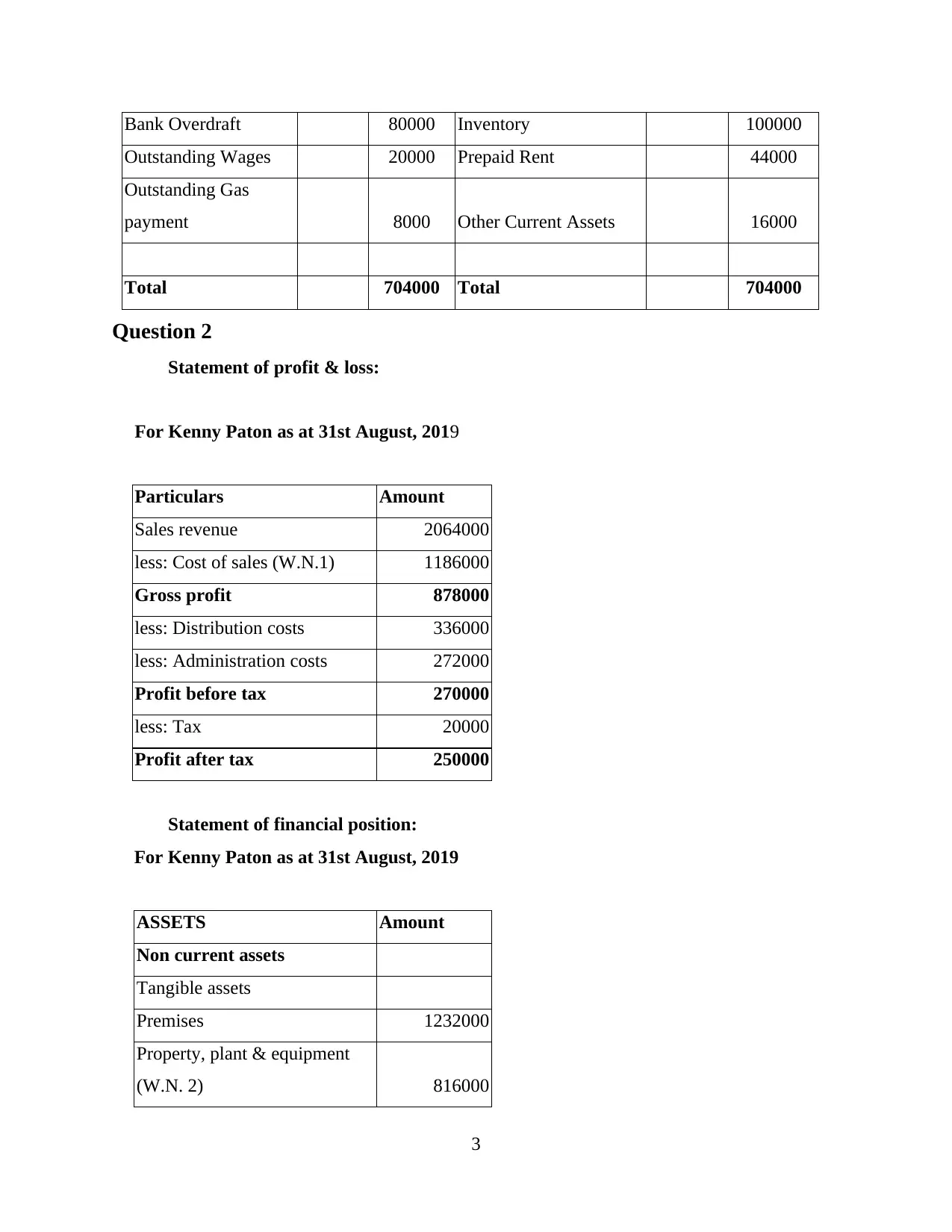
Bank Overdraft 80000 Inventory 100000
Outstanding Wages 20000 Prepaid Rent 44000
Outstanding Gas
payment 8000 Other Current Assets 16000
Total 704000 Total 704000
Question 2
Statement of profit & loss:
For Kenny Paton as at 31st August, 2019
Particulars Amount
Sales revenue 2064000
less: Cost of sales (W.N.1) 1186000
Gross profit 878000
less: Distribution costs 336000
less: Administration costs 272000
Profit before tax 270000
less: Tax 20000
Profit after tax 250000
Statement of financial position:
For Kenny Paton as at 31st August, 2019
ASSETS Amount
Non current assets
Tangible assets
Premises 1232000
Property, plant & equipment
(W.N. 2) 816000
3
Outstanding Wages 20000 Prepaid Rent 44000
Outstanding Gas
payment 8000 Other Current Assets 16000
Total 704000 Total 704000
Question 2
Statement of profit & loss:
For Kenny Paton as at 31st August, 2019
Particulars Amount
Sales revenue 2064000
less: Cost of sales (W.N.1) 1186000
Gross profit 878000
less: Distribution costs 336000
less: Administration costs 272000
Profit before tax 270000
less: Tax 20000
Profit after tax 250000
Statement of financial position:
For Kenny Paton as at 31st August, 2019
ASSETS Amount
Non current assets
Tangible assets
Premises 1232000
Property, plant & equipment
(W.N. 2) 816000
3
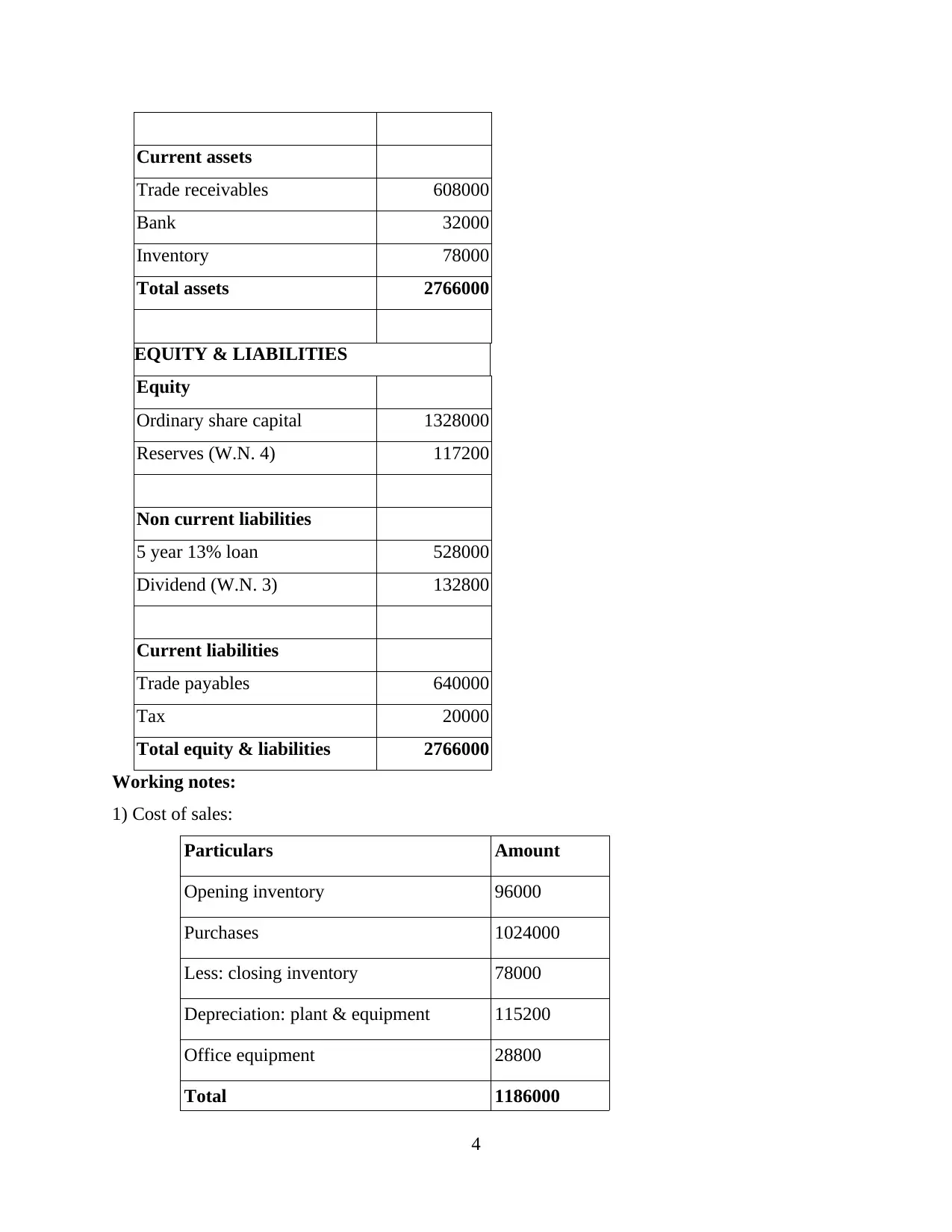
Current assets
Trade receivables 608000
Bank 32000
Inventory 78000
Total assets 2766000
EQUITY & LIABILITIES
Equity
Ordinary share capital 1328000
Reserves (W.N. 4) 117200
Non current liabilities
5 year 13% loan 528000
Dividend (W.N. 3) 132800
Current liabilities
Trade payables 640000
Tax 20000
Total equity & liabilities 2766000
Working notes:
1) Cost of sales:
Particulars Amount
Opening inventory 96000
Purchases 1024000
Less: closing inventory 78000
Depreciation: plant & equipment 115200
Office equipment 28800
Total 1186000
4
Trade receivables 608000
Bank 32000
Inventory 78000
Total assets 2766000
EQUITY & LIABILITIES
Equity
Ordinary share capital 1328000
Reserves (W.N. 4) 117200
Non current liabilities
5 year 13% loan 528000
Dividend (W.N. 3) 132800
Current liabilities
Trade payables 640000
Tax 20000
Total equity & liabilities 2766000
Working notes:
1) Cost of sales:
Particulars Amount
Opening inventory 96000
Purchases 1024000
Less: closing inventory 78000
Depreciation: plant & equipment 115200
Office equipment 28800
Total 1186000
4
⊘ This is a preview!⊘
Do you want full access?
Subscribe today to unlock all pages.

Trusted by 1+ million students worldwide
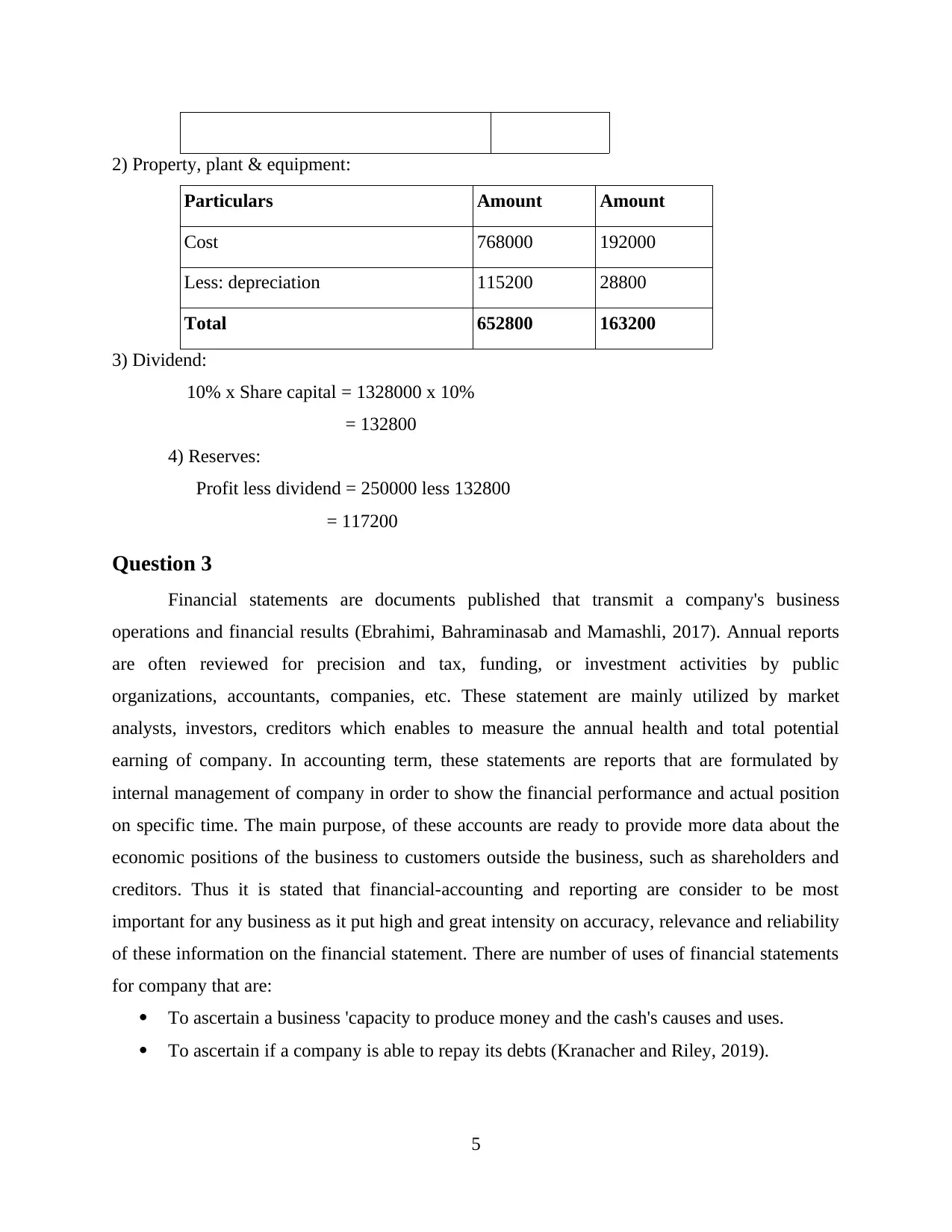
2) Property, plant & equipment:
Particulars Amount Amount
Cost 768000 192000
Less: depreciation 115200 28800
Total 652800 163200
3) Dividend:
10% x Share capital = 1328000 x 10%
= 132800
4) Reserves:
Profit less dividend = 250000 less 132800
= 117200
Question 3
Financial statements are documents published that transmit a company's business
operations and financial results (Ebrahimi, Bahraminasab and Mamashli, 2017). Annual reports
are often reviewed for precision and tax, funding, or investment activities by public
organizations, accountants, companies, etc. These statement are mainly utilized by market
analysts, investors, creditors which enables to measure the annual health and total potential
earning of company. In accounting term, these statements are reports that are formulated by
internal management of company in order to show the financial performance and actual position
on specific time. The main purpose, of these accounts are ready to provide more data about the
economic positions of the business to customers outside the business, such as shareholders and
creditors. Thus it is stated that financial-accounting and reporting are consider to be most
important for any business as it put high and great intensity on accuracy, relevance and reliability
of these information on the financial statement. There are number of uses of financial statements
for company that are:
To ascertain a business 'capacity to produce money and the cash's causes and uses.
To ascertain if a company is able to repay its debts (Kranacher and Riley, 2019).
5
Particulars Amount Amount
Cost 768000 192000
Less: depreciation 115200 28800
Total 652800 163200
3) Dividend:
10% x Share capital = 1328000 x 10%
= 132800
4) Reserves:
Profit less dividend = 250000 less 132800
= 117200
Question 3
Financial statements are documents published that transmit a company's business
operations and financial results (Ebrahimi, Bahraminasab and Mamashli, 2017). Annual reports
are often reviewed for precision and tax, funding, or investment activities by public
organizations, accountants, companies, etc. These statement are mainly utilized by market
analysts, investors, creditors which enables to measure the annual health and total potential
earning of company. In accounting term, these statements are reports that are formulated by
internal management of company in order to show the financial performance and actual position
on specific time. The main purpose, of these accounts are ready to provide more data about the
economic positions of the business to customers outside the business, such as shareholders and
creditors. Thus it is stated that financial-accounting and reporting are consider to be most
important for any business as it put high and great intensity on accuracy, relevance and reliability
of these information on the financial statement. There are number of uses of financial statements
for company that are:
To ascertain a business 'capacity to produce money and the cash's causes and uses.
To ascertain if a company is able to repay its debts (Kranacher and Riley, 2019).
5
Paraphrase This Document
Need a fresh take? Get an instant paraphrase of this document with our AI Paraphraser
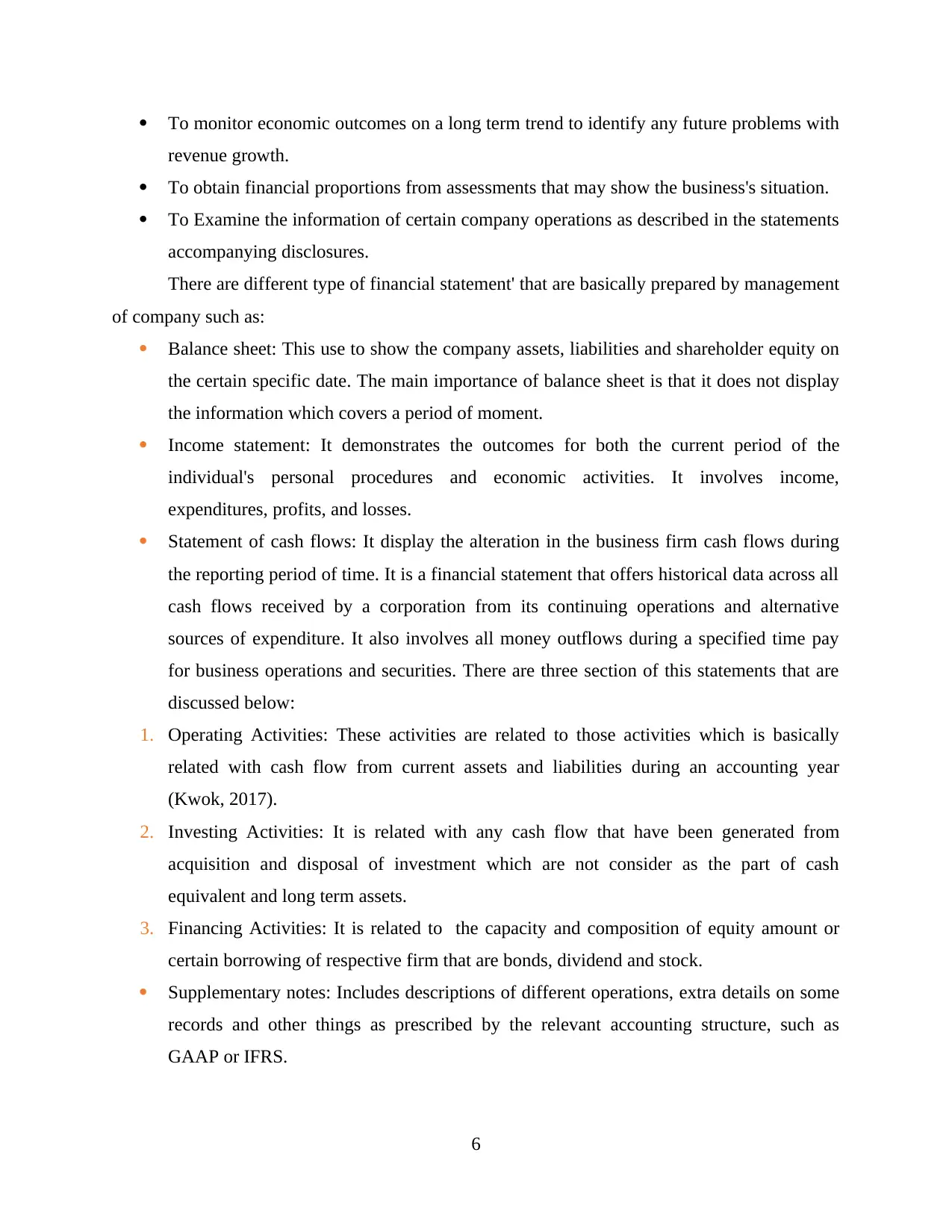
To monitor economic outcomes on a long term trend to identify any future problems with
revenue growth.
To obtain financial proportions from assessments that may show the business's situation.
To Examine the information of certain company operations as described in the statements
accompanying disclosures.
There are different type of financial statement' that are basically prepared by management
of company such as:
Balance sheet: This use to show the company assets, liabilities and shareholder equity on
the certain specific date. The main importance of balance sheet is that it does not display
the information which covers a period of moment.
Income statement: It demonstrates the outcomes for both the current period of the
individual's personal procedures and economic activities. It involves income,
expenditures, profits, and losses.
Statement of cash flows: It display the alteration in the business firm cash flows during
the reporting period of time. It is a financial statement that offers historical data across all
cash flows received by a corporation from its continuing operations and alternative
sources of expenditure. It also involves all money outflows during a specified time pay
for business operations and securities. There are three section of this statements that are
discussed below:
1. Operating Activities: These activities are related to those activities which is basically
related with cash flow from current assets and liabilities during an accounting year
(Kwok, 2017).
2. Investing Activities: It is related with any cash flow that have been generated from
acquisition and disposal of investment which are not consider as the part of cash
equivalent and long term assets.
3. Financing Activities: It is related to the capacity and composition of equity amount or
certain borrowing of respective firm that are bonds, dividend and stock.
Supplementary notes: Includes descriptions of different operations, extra details on some
records and other things as prescribed by the relevant accounting structure, such as
GAAP or IFRS.
6
revenue growth.
To obtain financial proportions from assessments that may show the business's situation.
To Examine the information of certain company operations as described in the statements
accompanying disclosures.
There are different type of financial statement' that are basically prepared by management
of company such as:
Balance sheet: This use to show the company assets, liabilities and shareholder equity on
the certain specific date. The main importance of balance sheet is that it does not display
the information which covers a period of moment.
Income statement: It demonstrates the outcomes for both the current period of the
individual's personal procedures and economic activities. It involves income,
expenditures, profits, and losses.
Statement of cash flows: It display the alteration in the business firm cash flows during
the reporting period of time. It is a financial statement that offers historical data across all
cash flows received by a corporation from its continuing operations and alternative
sources of expenditure. It also involves all money outflows during a specified time pay
for business operations and securities. There are three section of this statements that are
discussed below:
1. Operating Activities: These activities are related to those activities which is basically
related with cash flow from current assets and liabilities during an accounting year
(Kwok, 2017).
2. Investing Activities: It is related with any cash flow that have been generated from
acquisition and disposal of investment which are not consider as the part of cash
equivalent and long term assets.
3. Financing Activities: It is related to the capacity and composition of equity amount or
certain borrowing of respective firm that are bonds, dividend and stock.
Supplementary notes: Includes descriptions of different operations, extra details on some
records and other things as prescribed by the relevant accounting structure, such as
GAAP or IFRS.
6
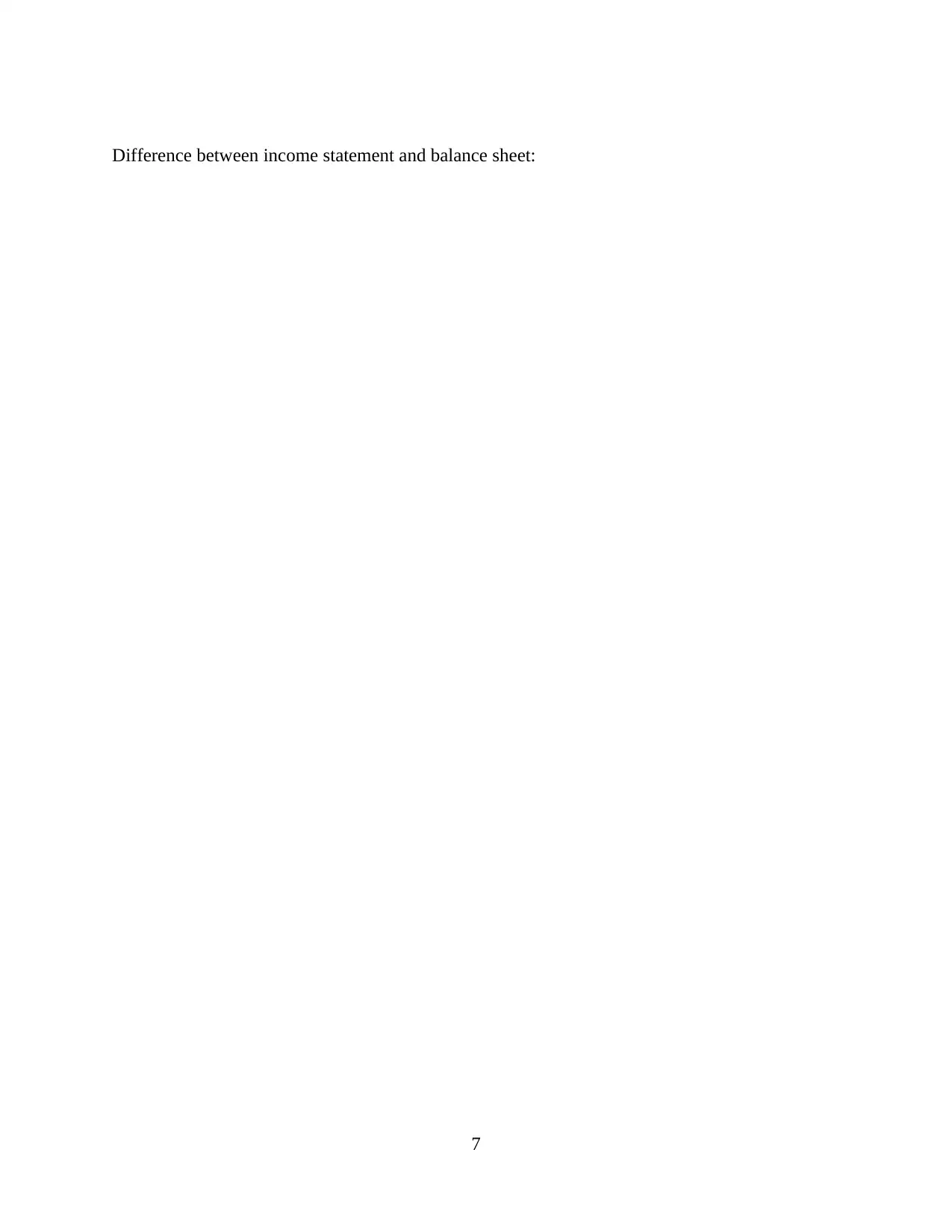
Difference between income statement and balance sheet:
7
7
⊘ This is a preview!⊘
Do you want full access?
Subscribe today to unlock all pages.

Trusted by 1+ million students worldwide
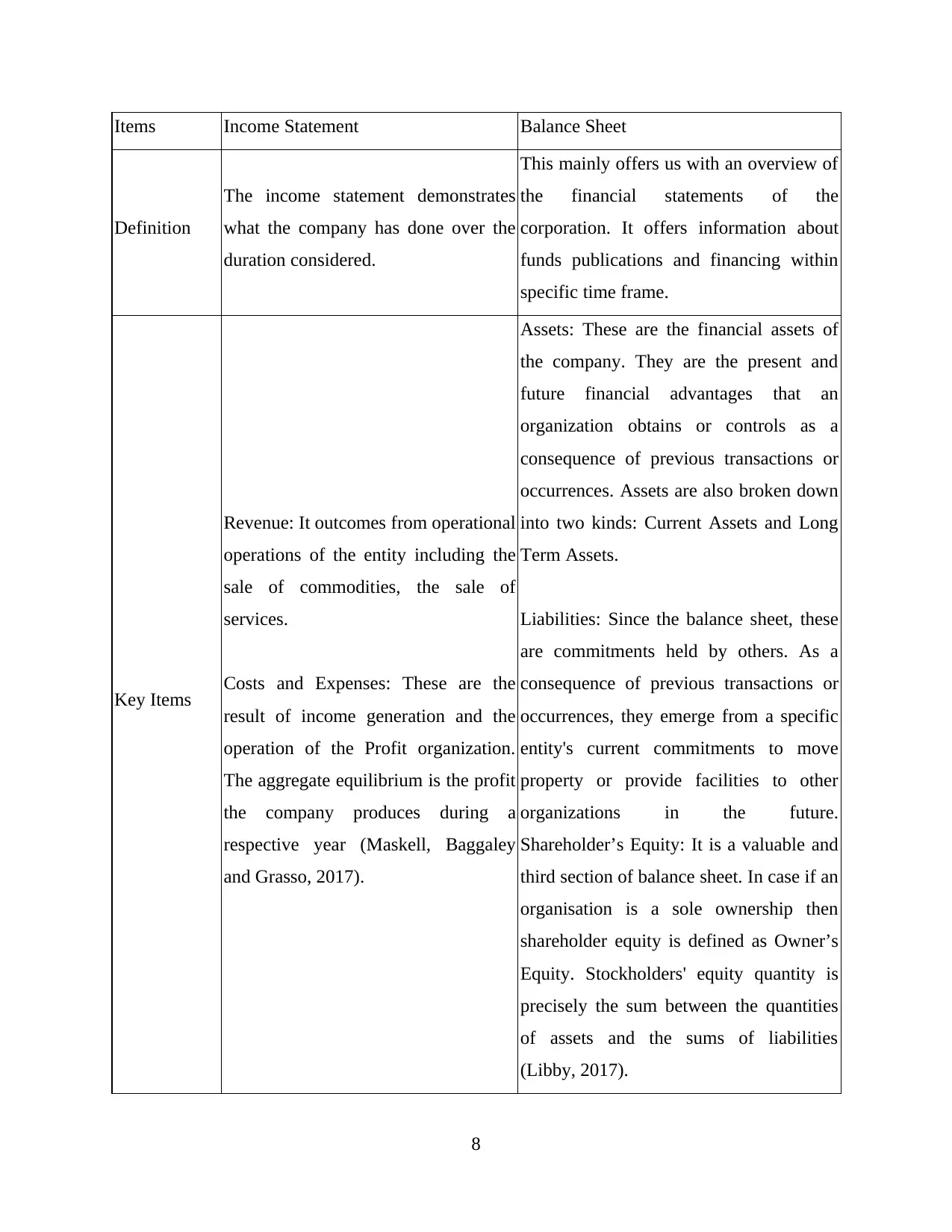
Items Income Statement Balance Sheet
Definition
The income statement demonstrates
what the company has done over the
duration considered.
This mainly offers us with an overview of
the financial statements of the
corporation. It offers information about
funds publications and financing within
specific time frame.
Key Items
Revenue: It outcomes from operational
operations of the entity including the
sale of commodities, the sale of
services.
Costs and Expenses: These are the
result of income generation and the
operation of the Profit organization.
The aggregate equilibrium is the profit
the company produces during a
respective year (Maskell, Baggaley
and Grasso, 2017).
Assets: These are the financial assets of
the company. They are the present and
future financial advantages that an
organization obtains or controls as a
consequence of previous transactions or
occurrences. Assets are also broken down
into two kinds: Current Assets and Long
Term Assets.
Liabilities: Since the balance sheet, these
are commitments held by others. As a
consequence of previous transactions or
occurrences, they emerge from a specific
entity's current commitments to move
property or provide facilities to other
organizations in the future.
Shareholder’s Equity: It is a valuable and
third section of balance sheet. In case if an
organisation is a sole ownership then
shareholder equity is defined as Owner’s
Equity. Stockholders' equity quantity is
precisely the sum between the quantities
of assets and the sums of liabilities
(Libby, 2017).
8
Definition
The income statement demonstrates
what the company has done over the
duration considered.
This mainly offers us with an overview of
the financial statements of the
corporation. It offers information about
funds publications and financing within
specific time frame.
Key Items
Revenue: It outcomes from operational
operations of the entity including the
sale of commodities, the sale of
services.
Costs and Expenses: These are the
result of income generation and the
operation of the Profit organization.
The aggregate equilibrium is the profit
the company produces during a
respective year (Maskell, Baggaley
and Grasso, 2017).
Assets: These are the financial assets of
the company. They are the present and
future financial advantages that an
organization obtains or controls as a
consequence of previous transactions or
occurrences. Assets are also broken down
into two kinds: Current Assets and Long
Term Assets.
Liabilities: Since the balance sheet, these
are commitments held by others. As a
consequence of previous transactions or
occurrences, they emerge from a specific
entity's current commitments to move
property or provide facilities to other
organizations in the future.
Shareholder’s Equity: It is a valuable and
third section of balance sheet. In case if an
organisation is a sole ownership then
shareholder equity is defined as Owner’s
Equity. Stockholders' equity quantity is
precisely the sum between the quantities
of assets and the sums of liabilities
(Libby, 2017).
8
Paraphrase This Document
Need a fresh take? Get an instant paraphrase of this document with our AI Paraphraser
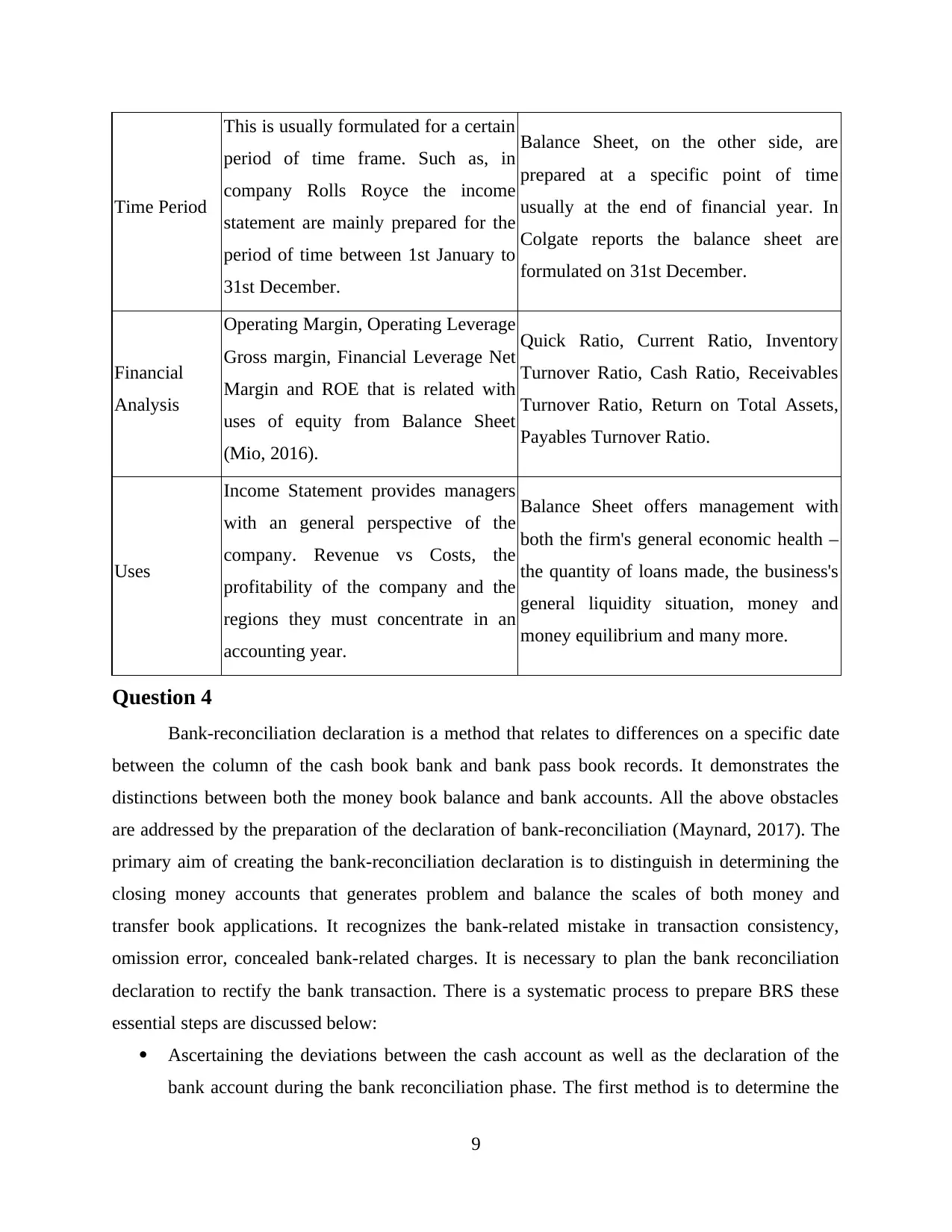
Time Period
This is usually formulated for a certain
period of time frame. Such as, in
company Rolls Royce the income
statement are mainly prepared for the
period of time between 1st January to
31st December.
Balance Sheet, on the other side, are
prepared at a specific point of time
usually at the end of financial year. In
Colgate reports the balance sheet are
formulated on 31st December.
Financial
Analysis
Operating Margin, Operating Leverage
Gross margin, Financial Leverage Net
Margin and ROE that is related with
uses of equity from Balance Sheet
(Mio, 2016).
Quick Ratio, Current Ratio, Inventory
Turnover Ratio, Cash Ratio, Receivables
Turnover Ratio, Return on Total Assets,
Payables Turnover Ratio.
Uses
Income Statement provides managers
with an general perspective of the
company. Revenue vs Costs, the
profitability of the company and the
regions they must concentrate in an
accounting year.
Balance Sheet offers management with
both the firm's general economic health –
the quantity of loans made, the business's
general liquidity situation, money and
money equilibrium and many more.
Question 4
Bank-reconciliation declaration is a method that relates to differences on a specific date
between the column of the cash book bank and bank pass book records. It demonstrates the
distinctions between both the money book balance and bank accounts. All the above obstacles
are addressed by the preparation of the declaration of bank-reconciliation (Maynard, 2017). The
primary aim of creating the bank-reconciliation declaration is to distinguish in determining the
closing money accounts that generates problem and balance the scales of both money and
transfer book applications. It recognizes the bank-related mistake in transaction consistency,
omission error, concealed bank-related charges. It is necessary to plan the bank reconciliation
declaration to rectify the bank transaction. There is a systematic process to prepare BRS these
essential steps are discussed below:
Ascertaining the deviations between the cash account as well as the declaration of the
bank account during the bank reconciliation phase. The first method is to determine the
9
This is usually formulated for a certain
period of time frame. Such as, in
company Rolls Royce the income
statement are mainly prepared for the
period of time between 1st January to
31st December.
Balance Sheet, on the other side, are
prepared at a specific point of time
usually at the end of financial year. In
Colgate reports the balance sheet are
formulated on 31st December.
Financial
Analysis
Operating Margin, Operating Leverage
Gross margin, Financial Leverage Net
Margin and ROE that is related with
uses of equity from Balance Sheet
(Mio, 2016).
Quick Ratio, Current Ratio, Inventory
Turnover Ratio, Cash Ratio, Receivables
Turnover Ratio, Return on Total Assets,
Payables Turnover Ratio.
Uses
Income Statement provides managers
with an general perspective of the
company. Revenue vs Costs, the
profitability of the company and the
regions they must concentrate in an
accounting year.
Balance Sheet offers management with
both the firm's general economic health –
the quantity of loans made, the business's
general liquidity situation, money and
money equilibrium and many more.
Question 4
Bank-reconciliation declaration is a method that relates to differences on a specific date
between the column of the cash book bank and bank pass book records. It demonstrates the
distinctions between both the money book balance and bank accounts. All the above obstacles
are addressed by the preparation of the declaration of bank-reconciliation (Maynard, 2017). The
primary aim of creating the bank-reconciliation declaration is to distinguish in determining the
closing money accounts that generates problem and balance the scales of both money and
transfer book applications. It recognizes the bank-related mistake in transaction consistency,
omission error, concealed bank-related charges. It is necessary to plan the bank reconciliation
declaration to rectify the bank transaction. There is a systematic process to prepare BRS these
essential steps are discussed below:
Ascertaining the deviations between the cash account as well as the declaration of the
bank account during the bank reconciliation phase. The first method is to determine the
9
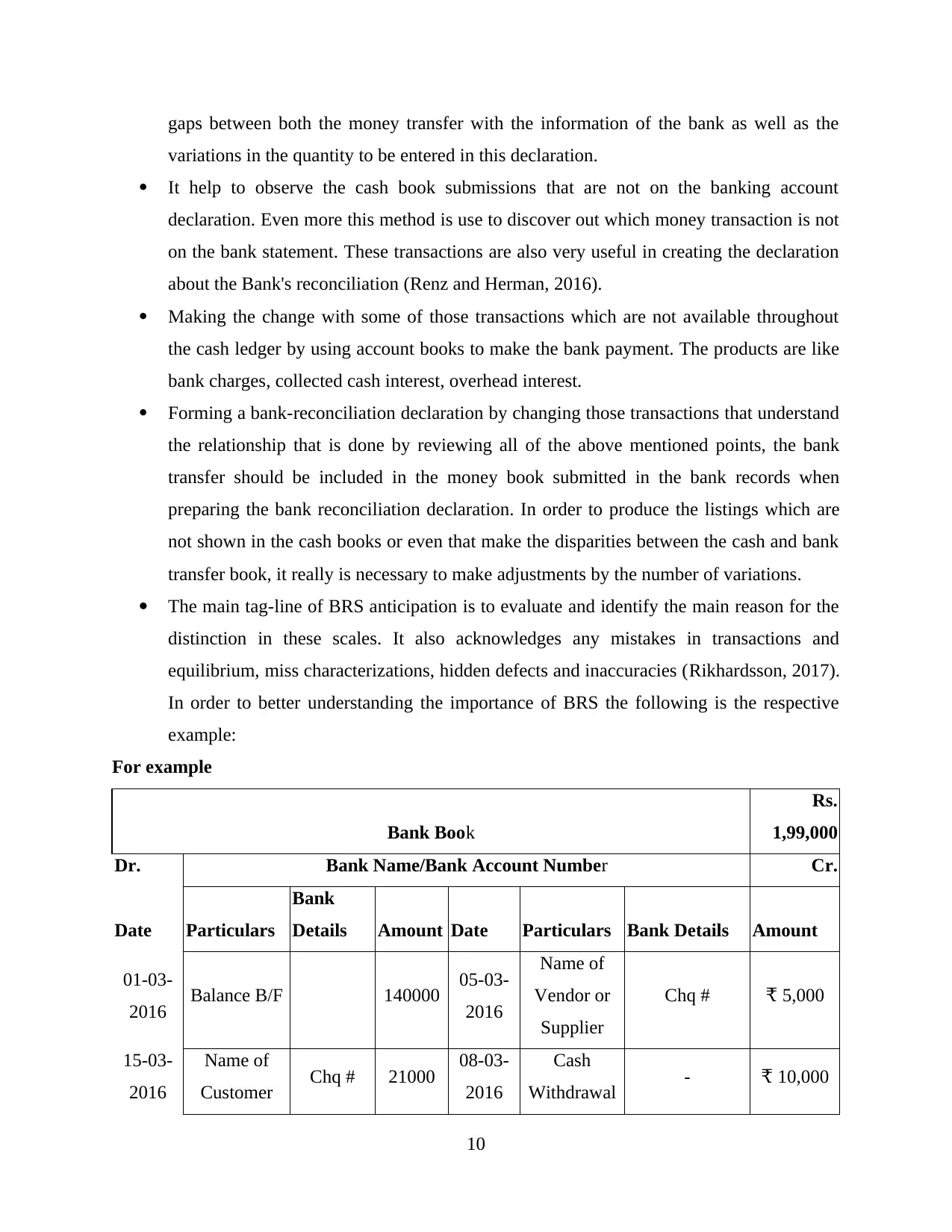
gaps between both the money transfer with the information of the bank as well as the
variations in the quantity to be entered in this declaration.
It help to observe the cash book submissions that are not on the banking account
declaration. Even more this method is use to discover out which money transaction is not
on the bank statement. These transactions are also very useful in creating the declaration
about the Bank's reconciliation (Renz and Herman, 2016).
Making the change with some of those transactions which are not available throughout
the cash ledger by using account books to make the bank payment. The products are like
bank charges, collected cash interest, overhead interest.
Forming a bank-reconciliation declaration by changing those transactions that understand
the relationship that is done by reviewing all of the above mentioned points, the bank
transfer should be included in the money book submitted in the bank records when
preparing the bank reconciliation declaration. In order to produce the listings which are
not shown in the cash books or even that make the disparities between the cash and bank
transfer book, it really is necessary to make adjustments by the number of variations.
The main tag-line of BRS anticipation is to evaluate and identify the main reason for the
distinction in these scales. It also acknowledges any mistakes in transactions and
equilibrium, miss characterizations, hidden defects and inaccuracies (Rikhardsson, 2017).
In order to better understanding the importance of BRS the following is the respective
example:
For example
Bank Book
Rs.
1,99,000
Dr. Bank Name/Bank Account Number Cr.
Date Particulars
Bank
Details Amount Date Particulars Bank Details Amount
01-03-
2016 Balance B/F 140000 05-03-
2016
Name of
Vendor or
Supplier
Chq # ₹ 5,000
15-03-
2016
Name of
Customer Chq # 21000 08-03-
2016
Cash
Withdrawal - ₹ 10,000
10
variations in the quantity to be entered in this declaration.
It help to observe the cash book submissions that are not on the banking account
declaration. Even more this method is use to discover out which money transaction is not
on the bank statement. These transactions are also very useful in creating the declaration
about the Bank's reconciliation (Renz and Herman, 2016).
Making the change with some of those transactions which are not available throughout
the cash ledger by using account books to make the bank payment. The products are like
bank charges, collected cash interest, overhead interest.
Forming a bank-reconciliation declaration by changing those transactions that understand
the relationship that is done by reviewing all of the above mentioned points, the bank
transfer should be included in the money book submitted in the bank records when
preparing the bank reconciliation declaration. In order to produce the listings which are
not shown in the cash books or even that make the disparities between the cash and bank
transfer book, it really is necessary to make adjustments by the number of variations.
The main tag-line of BRS anticipation is to evaluate and identify the main reason for the
distinction in these scales. It also acknowledges any mistakes in transactions and
equilibrium, miss characterizations, hidden defects and inaccuracies (Rikhardsson, 2017).
In order to better understanding the importance of BRS the following is the respective
example:
For example
Bank Book
Rs.
1,99,000
Dr. Bank Name/Bank Account Number Cr.
Date Particulars
Bank
Details Amount Date Particulars Bank Details Amount
01-03-
2016 Balance B/F 140000 05-03-
2016
Name of
Vendor or
Supplier
Chq # ₹ 5,000
15-03-
2016
Name of
Customer Chq # 21000 08-03-
2016
Cash
Withdrawal - ₹ 10,000
10
⊘ This is a preview!⊘
Do you want full access?
Subscribe today to unlock all pages.

Trusted by 1+ million students worldwide
1 out of 16
Related Documents
Your All-in-One AI-Powered Toolkit for Academic Success.
+13062052269
info@desklib.com
Available 24*7 on WhatsApp / Email
![[object Object]](/_next/static/media/star-bottom.7253800d.svg)
Unlock your academic potential
Copyright © 2020–2025 A2Z Services. All Rights Reserved. Developed and managed by ZUCOL.





